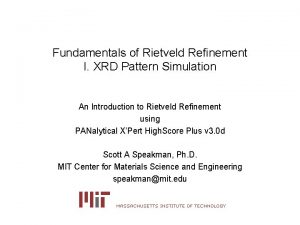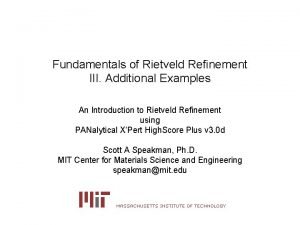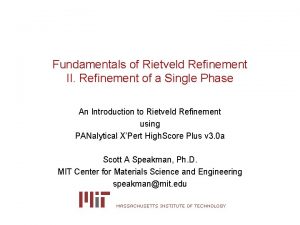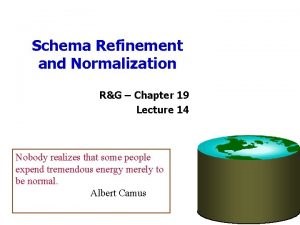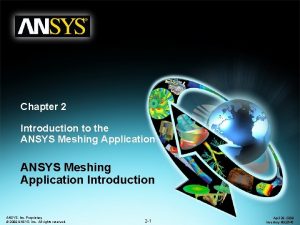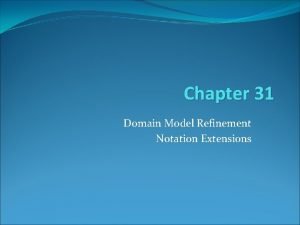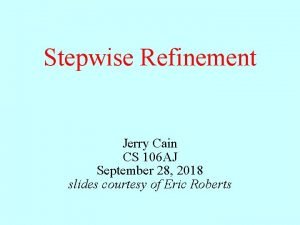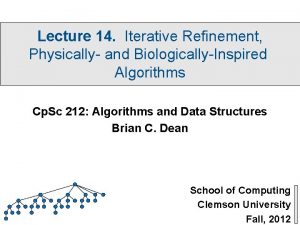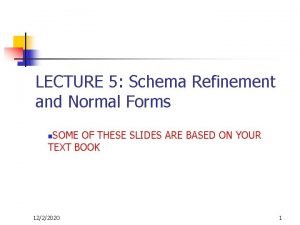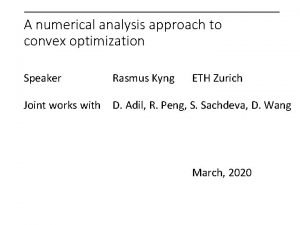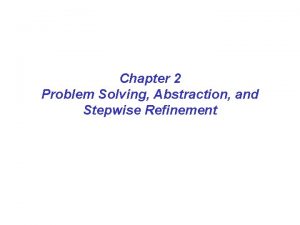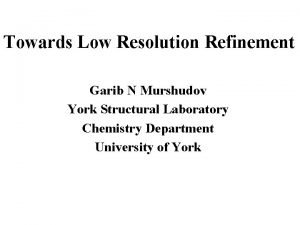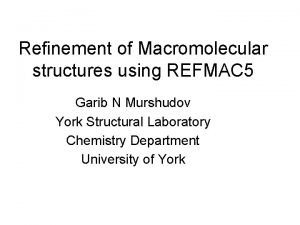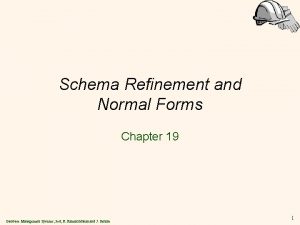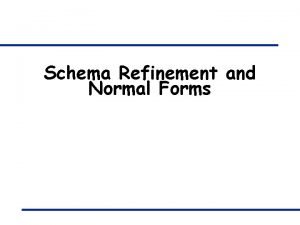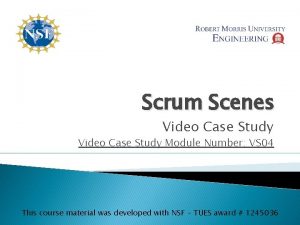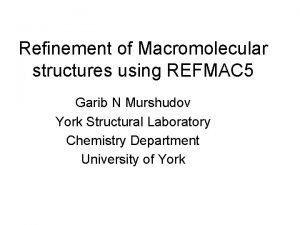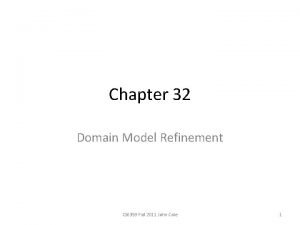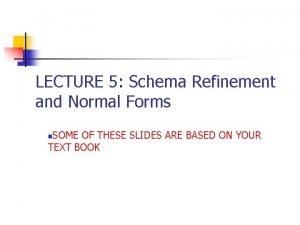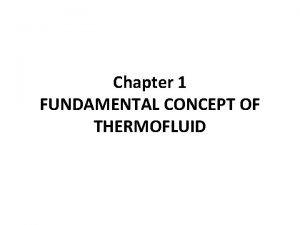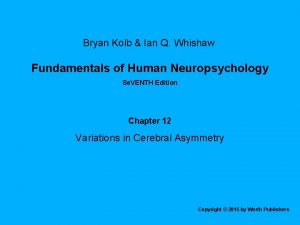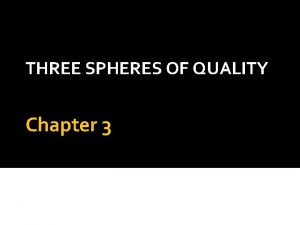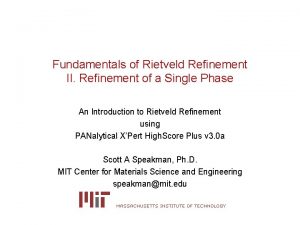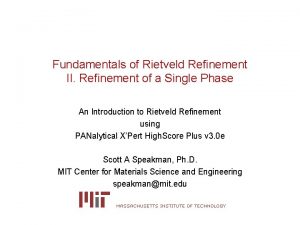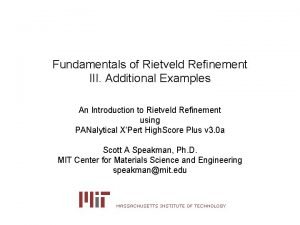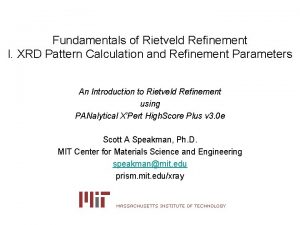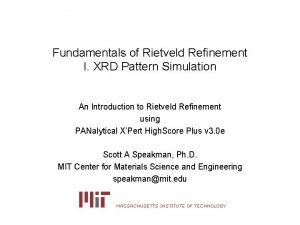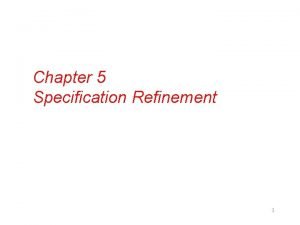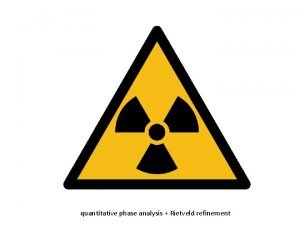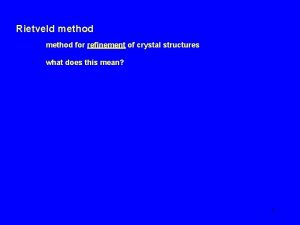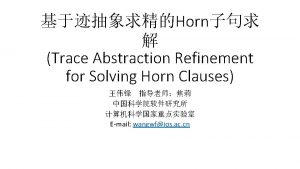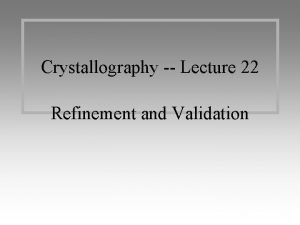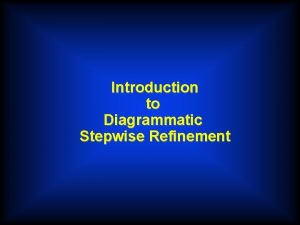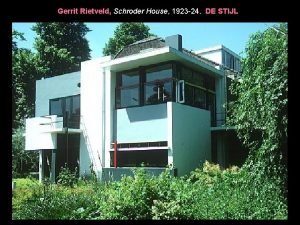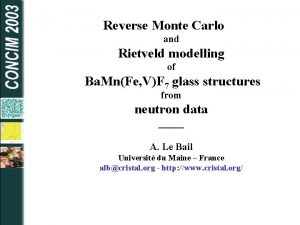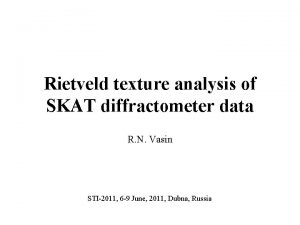Fundamentals of Rietveld Refinement III Refinement of a


































- Slides: 34

Fundamentals of Rietveld Refinement III. Refinement of a Mixture An Introduction to Rietveld Refinement using PANalytical X’Pert High. Score Plus v 3. 0 e Scott A Speakman, Ph. D. MIT Center for Materials Science and Engineering speakman@mit. edu

We are going to determine the phases present in a mixture and then refine that mixture • These exercises will remind you of what we did previously and demonstrate a few extra features • 1. 2. 3. The steps for this exercise: Enable the COD database Determine what phases are present in this sample Perform a Rietveld refinement of the mixture

Adding a Database to High. Score Plus • The free COD database was downloaded from http: //www. crystallograp hy. net/new. html – Alternatively, you may have installed the ICDD PDF 4 database • • In High. Score Plus, go to menu Customize > Manage Databases Click on Add High. Score Database Navigate and select the COD database with a *. hsrdb extension Make sure that the Use column is checked – If the Writable column is checked, you will be able to add your own entries to the database

Phase Identification: fit the background 1. Open the file “hydrated abalone. xrdml” 2. Fit the background – – Set the y-axis to square root scale Select menu Treatment > Determine Background… • Use Granularity between 10 to 30 • Use Bending Factor 0 or 1 • Click Accept; – never Subtract the background » Unless you really want to

Phase Identification: Peak Search 3. Locate the diffraction peaks – – Select menu Treatment > Search Peaks… Use the “Identify” parameter set • Click on the More button • Select Identify from the drop-down menu Click on the Search Peaks button Evaluate the Results • Modify the search parameters and click Search Peaks again • If the search results are good, click on the Accept button

Phase Identification: Run the Search & Match • Run the phase identification Search & Match algorithm • Select menu Analysis > Search & Match > Execute Search & Match – Use the “Default” parameter set to start • Click on the More button • Select Default from the drop-down menu

We are going to create a Search & Match routine that only retrieves reference patterns that contain crystal structures that can be used in our Rietveld refinement • • • Click on the Restrictions tab Select the Restriction set radio button Click on the Edit Restriction Sets button In the new window that opens, select the Quality tab, Check “Skip patterns without structure data” – You might also want to check • Skip non-ambient temperature • Skip non-ambient pressure • Save the Restrictions Parameter Set – Click on the floppy disk icon • • Click Close Save the Search & Match Parameter Set – Click on the floppy disk icon

Phase Identification: Determine Good Matches • Click on the Search button • Click OK when the search is done • Look through the candidate list and determine if any of the highest scored phases are a good match • If they are, then move them to the Accepted Pattern list • The program automatically rescores the candidates – you should find another match at the top of the newly resorted candidate list • Once you have identified all of the relevant phase, clear the candidate list – Right-click in the candidate list – Select “Remove All Candidates” – This will speed up the program

Need more help with Search & Match procedures? • In the HELP, look under the Quick Start Guide – Performing Search-Match Identify – Phase Identification Strategy – You may also have a printed copy of the Quick Start Guide • In the HELP, look under Analysis > Phase Analysis • Online, look at http: //www. icdd. com/resources/tutori als/ – Data Mining- Trace Phase Analysis – Other tutorials

Refining a sample with two phases present • Our Phase ID shows that both aragonite and calcite phases are present • Set refinement mode to “Semi-Automatic” • We need to transfer the crystal structures from the reference cards into our refinement control – In the Pattern List, select both phases • Select multiple phases by using Shift + Click – Right-click in the Pattern List and select “Convert Pattern to Phase” – Select Refinement Control in the Lists Pane • You will see that aragonite and calcite have been entered into the refinement control

Global Parameters in the refinement will affect both phases • The Global Parameters will affect both phases – background – specimen displacement or zero shift – POL correction • Phase parameters are refined separately for each phase • We are going to use the background that we manually fit in order to make the refinement a little easier – Select Refinement Control tab in the Lists Pane – Click on “Global Variables” – In the Object Inspector, under Background set the method to “Use Available Background” – This approach works very well for complex mixtures or diffraction patterns that have a lot of overlapping peaks

Shortcut for refining parameters from multiple phases • Right-click on any field in the Refinement Control list • The “Refine All” and “Fix All” choices will set refinement of a parameter for all of the phases loaded into the refinement model • Remember, you can use “Show Refined Values/Constraints. . . ” to keep track of all of the parameters that are currently being refined

The refinement of multiple phases proceeds similarly to that of single phases 1. Refine the scale factor for both aragonite and calcite 1. Right-click on any field in the Refinement Control list 2. select Refine All > Scale Factors 3. Click on the Start Rietveld Refinement button 2. Refine ‘Specimen Displacement’ to adjust peak positions 1. In the Global Variables field of the Refinement Control list, put a check mark next to Specimen Displacement 2. click on the Start Rietveld Refinement button

Excluding problematic regions to improve the refinement • Background at high angles doesn’t fit so well • we can either try fitting it or ignore it • We will ignore it – Select menu Analysis > Rietveld > Edit Excluded Regions – Click New Region • type 68 for start • type 70 for end – click OK • Run the refinement again without adding additional refinement terms

Refining parameters for individual phases requires some consideration • Refining Lattice Parameters– should the sample have similar or different lattice parameters from those in the initial crystal structure? – this sample is from the shell of abalone, a sea snail – crystal structures from NBS data for synthetic analogues to the mineral – it would be reasonable for the lattice parameters to be slightly different • If the lattice parameters from the initial structure should be accurate to the sample in consideration, then maybe refine the profile parameters before refining the lattice parameters • In this case, we will refine the lattice parameters for both phases – right-click in the Refinement Control list – select Refine All > Cells

Refining peak profiles in multiphase samples should be done cautiously if there a lot of overlapping peaks • Sometimes, Rietveld refinement code will make the peaks from one phase very wide – The code is trying to use a wide peak from phase 1 to account for intensity from phase 2 – Sometimes, the code tries to improve a poor fit to the background by making the diffraction peaks very wide • refine W, V, and U for both phases – refine each Cagliotti peak width parameter one at a time – again, using the “Refine All” and “Fix All” options can save a lot of time • refine Peak Shape Parameter 1

Evaluate the Quality of the Refinement • Evaluate the refinement – how good is it? – The Weighted R profile is ~22% • The R expected is 2. 6% – when you click on a phase name in the Refinement Control list, you will see a highlighted trace emphasizing that phase alone • If this does not work, select menu View > Display Mode > Show Selected Phase Profile

Problems with Refinement • Aragonite – peaks at 31 deg (002) and 33 deg (012) for aragonite do not have enough intensity – suggests [002] preferred orientation • Peak profiles do not vary properly – high angle peaks in experimental data are sharper than as fit with simulation • If you refine B Overall for both samples, the B for calcite is much larger than for aragonite – this sort of thing often suggest sample preparation problems • For all of these problems, once the preferred orientation is accounted for the calculated weight fractions for the mixture is good

Let’s refine another sample 1. In Refinement Control, right-click and select Fix All > Refined Parameters 2. Select the Scan List 3. Right-click on the scan and select Remove Scan 4. insert dry abalone. xrdml 1. Select File > Insert 5. Fit the background 1. Select Treatment > Determine Background 6. Select the Refinement Control List 1. Both phases are still present in the Refinement Control List 7. Refine scale factor for both phases 8. Refine specimen displacement • without much work, what do we learn about this sample?

• If we were interested in investing more time for this analysis, a good approach would be: – refine the aragonite structure in the dry abalone data file, since the single phase sample will be much easier to refine than the mixture – feed the phase parameters (lattice parameters, preferred orientation, B overall, profile parameters, etc) for aragonite from the single phase dry abalone sample into the refinement of the mixture in hydrated abalone sample

1. Crystallite Size Analysis 1. 2. 3. 4. Refining an instrument profile standard Using the result to create a template Refining a nanocrystalline sample Improving the refinement by using Le. Bail fitting

Using a template for nanocrystallite size analysis • We are going to refine a Ceria (Ce. O 2) standard • This will be used to determine the U, V, and W that is characteristic for the instrument profile of our diffractometer • We will use the result to create a template that can then be used in the analysis of nanocrystalline Ceria • Open Ceria Standard. xrdml • Insert Ceria Structure. cif • Refine the model

Use the results of the previous refinement to create instrument profile parameters • In the Refinement Control list, rightclick on the phase name – you need to click on the phase name, not on any other field – select “Take as Size-Strain Standard” – this exports the U, V, and W values into the Global Parameters object as U standard, V standard, and W standard – these values will be used to determine how a sample profile is broadened due to crystallite size and/or microstrain

A template can be used as a starting point for multiple analyses of experimental data • You could record the Caglioti coefficients from the Instrument Standard field and them enter into every new document – If you are not sharing a computer and only use one instrument with one configuration, you could also save them as defaults in the menu Customize > Defaults • In order to save work, you can also create a template file – A template file is an empty HPF document that contains several settings – We will create a document that contains the Caglioti coefficients determined by the analysis of the standard – A template can also contain • Reference patterns • Peaks in the peak list • Phases for refinement

Creating a template • After you create the Size-Strain Standard – Go to the Peak List tab in the Lists Pane • Right-click in the Peak List and select the menu option Delete > Included Peaks – Go to the Refinement Control tab in the Lists Pane • Expand the entries Global Variables and Background • In every parameter within Background (Flat Background, Coefficient 1, etc), set the value to 0 • Remove the Phases if your specimen is a different material – Go to the Pattern List in the Lists Pane • Delete all reference patterns loaded in the Pattern List • If you are always analyzing the same phase(s), you could load the reference patterns for those phases and save them in the template – Go to the Scan List in the Lists Pane • Delete all experimental scans loaded in the Scan List • Save the document in a *. HPF format with a clever name like “LP Analysis Template. hpf

To determine the crystallite size, you need to specify the sample broadening analysis for each phase • To analyze the nanocrystalline specimen, insert the file “ceria nanophase. xrdml” into the template file • Go to the Refinement Control list • Click on the phase name for the ceria structure • In the Object Inspector, find the Phase Profile area • In the field Size Strain Analysis, from the drop-down menu you should select either “Size Only” or “Size and Strain”

Refine the sample to determine the crystallite size • The Cagliotti parameters will be used to determine how size and strain creates broadening of the sample – V will not be refined – U and W will be refined according to the Size-Strain analysis specific in the phase settings • After refinement, you can find the calculated size and/or strain from in the Object Inspector for the phase, under Derived Data

Templates can be used to facilitate analysis of a number of sample types • For QPA of mixtures, refine a mixture and save the result as a template – this will preserve the refined lattice parameters, peak profiles parameters, and preferred orientation coefficient – using this as a starting point for analysis of similar mixtures can make it faster

Fixing the ceria refinement using Le. Bail (structureless) fitting • Because of poor sample preparation, the intensity does not vary properly as a function of 2 theta – the experimental intensity at large angles 2 theta are incorrect • We can accurately determine lattice parameters and crystallite size broadening even if the intensity is off – this assumes that the errors affecting intensity do not affect the peak positions or peak profiles • To fit data with a systematic error in intensity, we will arbitrarily fit the intensity of each peak – instead of calculating the intensity from the structure factor from the crystal structure of the phase

To start the Le. Bail fit • click on the phase name in the Refinement Control list – In the General Phase Info field of the Object Inspector change the fitting mode from Structure Fit to Le-Bail Fit • Right-click on any field in the Refinement Control list – select “Fix All” – select “Refined Parameters” • Run a refinement in Semi-automatic mode • This iteration of refinement is used to fit the intensity of each individual peak – peak positions and peak profiles are still constrained by the parameters of the phase, such as lattice parameter and Cagliotti parameters

Preferred Orientation • First, identify the direction of the preferred orientation – Begin the Rietveld refinement of the data – Turn on (hkl) labelling of peaks • Right-click in the Main Graphics window and select Label Peaks • In the Label Peaks dialog, select HKL • Click OK • The peaks will now be labelled • This only works if the calculated pattern has been simulated or refined

Preferred Orientation • Look at the (hkl) values for obvious trends in intensity vs. geometry – Remember that (hkl) is parallel to (n*h n*k n*l) – For example, (011) and (022) are parellel – In the plot to the right, the (011) and (022) peaks are both stronger than calculated – All other peaks are weaker than calculated – This indicates a [011] preferred orientation – Sometimes a related set of peaks will be weaker rather than stronger; this corresponds to a needle-like particle shape

Defining Preferred Orientation with the March. Dollase function • March-Dollase is defined assuming one axis is fixed in its orientation and the other two axes have freedom of rotation – If the March-Dollase parameter is <1, then the fixed axis is normal to the surface of the sample (parallel to the diffraction vector s) and [hkl] is defined as the fixed axis which will produce diffraction peaks stronger than otherwise predicted – If the March-Dollase parameter is >1, then the fixed axis is parallel to the surface of the sample (normal to the diffraction vector s) and [hkl] is defined as the fixed axis which will produce diffraction peaks weaker than otherwise predicted

Set the preferred orientation direction in the Object Inspector window for the selected phase Flag the preferred orientation parameter to refine here Set the preferred orientation direction here
 Fundamentals of rietveld refinement
Fundamentals of rietveld refinement Rietveld refinement highscore plus
Rietveld refinement highscore plus Fundamentals of rietveld refinement
Fundamentals of rietveld refinement Scott a speakman
Scott a speakman Hamlet act iii scene iii
Hamlet act iii scene iii Introduction to schema refinement
Introduction to schema refinement Purpose of normalization or schema refinement
Purpose of normalization or schema refinement Ansys element quality
Ansys element quality Pos domain model
Pos domain model Stepwise refinement python
Stepwise refinement python Iterative refinement
Iterative refinement Refinement
Refinement Relation instance
Relation instance T-tess triangle
T-tess triangle What is risk refinement in software engineering
What is risk refinement in software engineering Iterative refinement
Iterative refinement Define stepwise refinement
Define stepwise refinement Jelly body refinement
Jelly body refinement Shelxl download
Shelxl download Schema refinement and normal forms
Schema refinement and normal forms What is schema refinement
What is schema refinement Backlog refinement
Backlog refinement Jelly body refinement
Jelly body refinement Domain model refinement
Domain model refinement Schema refinement and normal forms
Schema refinement and normal forms Bulk deformation and sheet metal forming
Bulk deformation and sheet metal forming Security guide to network security fundamentals
Security guide to network security fundamentals What simple tenses are the fundamentals of english grammar
What simple tenses are the fundamentals of english grammar Fundamentals of thermal-fluidsciences chapter 1 problem 13p
Fundamentals of thermal-fluidsciences chapter 1 problem 13p Spatial and temporal redundancy in digital image processing
Spatial and temporal redundancy in digital image processing Kolb whishaw fundamentals of human neuropsychology
Kolb whishaw fundamentals of human neuropsychology The fundamentals of political science research 2nd edition
The fundamentals of political science research 2nd edition Fundamentals of investment notes
Fundamentals of investment notes Spheres
Spheres Fundamentals of throwing a football
Fundamentals of throwing a football
